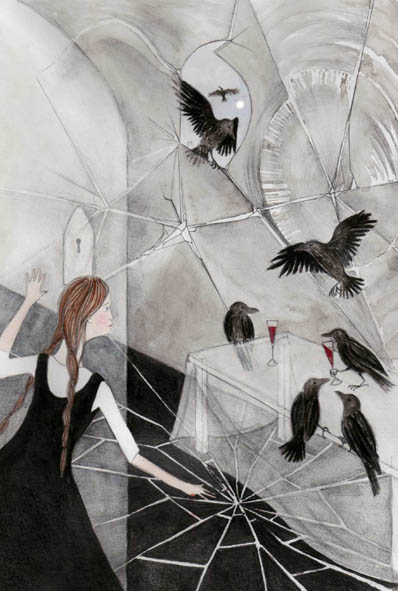[CW: self-mutilation]
Aarne-Thompson-Uther Index type 451: The Nurse Looking for Her Brothers

If you’ve been paying attention, you’ll notice that we covered this tale type in ‘The Twelve Brothers.’ As I’ve mentioned before, these are my very favorite tale types (there’s probably something pathological related to my own devotion to, and over-dependence on, my big brother but we won’t go into that).
Anyway, this story has been told in a number of ways and the basic gist is pretty much always the same: a varying number of older brothers get turned into some kind of bird (usually swans, geese, ducks, or ravens) by a female family member that wants them to just go away and and so the clever and devoted little sister must search them out and break their curse. There are some variations that don’t include the brothers turning into birds, like the North African story “Udea and Her Seven Brothers,” but even that involves assistance from ravens and pigeons.
The other piece that is vitally important to these stories is that the sister goes through a series of trials that are required to free her brothers from their curse and bring them home. These trials are almost always brutal, torturous, and sure to leave the little sister with an absurd amount of PTSD:
The sister continued her journey, and she went so far, so very far, until she came to the end of the world and went to the sun, which was, however, much too hot and ate small children.

The interesting thing about this particular variation is that it is possibly the least well known. It was told to the Grimm’s by the Hassenpflugs, who seemed to have an inexhaustible store of fairy tales and folklore in their family. The story was originally told to the Grimms as “The Three Ravens” but by the second edition, in 1819, it had evolved and and been rewritten in to “The Seven Ravens.” The long-suffering little sister did not change, however:
So after that she went to the moon, which was, however, much too cold and also mean, and when it saw her, it said, “I smell, I smell human flesh!”

Now, in this version, the brothers are turned into ravens because their mother caught them playing cards when they should have been in church. Harsh, I know, but you gotta respect the spell-casting chops on that mom. That’s pretty impressive.
While quite a few variations involve a geas wherein the little sister cannot speak for the duration of her quest to break the curse, and many variations involve weaving garments out of nettles, this one is a bit lighter in that area. That doesn’t mean it’s not still treacherous to her life. Having said that, there are beings that enter the story with the intention of helping the exhausted little sister.
So the maiden left there quickly and went to the stars, which were good to her, and each one sat on a little stool, and the morning star stood up and gave her a gammy leg to help her open the gate to the glass mountain.

Eventually, the little sister locates her brothers, though she has to sacrifice part of a finger to do this. The brothers almost give her the Goldilocks treatment until they see that she is in possession of a ring that they recognize. After seeing the ring, the curse is immediately broken and the brothers transform back into their human selves and everyone goes home.
As I was reading about this story, I came across differing analyses, which is to be expected with any fairytale. Some of the explanations I found suggest that this calls back to a time when men were constantly going to war. This often necessitated a daughter being left behind as the soul heir to the family fortune through the simple matter of ultimogeniture. In that time and place, this would have made the girl vulnerable to men that stayed behind (see Penelope).
Essentially, the sister is searching for her brothers and wants to bring them home in order to relieve her of this burden. Of course, this can’t be the entire analysis, given that customs differ from place to place and what holds true for Western European women doesn’t necessarily hold true for women in North Africa.

My own analyses is that this tale type demonstrates the sheer amount of work that women do for their families. This was a period when war was the norm and women were left at home to maintain the hearth fires. It would have been lonely and exhausting and terrifying and filled with hard work and worry. A woman can’t be blamed for wanting her brothers to come home and take up their share of the burden.
And too, I think it shows the familial bonds and the safety that a sister might find with her brothers that she couldn’t necessarily find with other men in that time and place. This doesn’t mean that women didn’t have rotten brothers back then. They definitely did but there are some bonds between brothers and sisters that are unshakeable and ever faithful.
Work Cited:
Grimm, Jacob; Grimm, Wilhelm. The Original Folk and Fairy Tales of the Brothers Grimm: The Complete First Edition. Princeton University Press. Kindle Edition.

One thought on “#FairytaleTuesday: The Three Ravens”